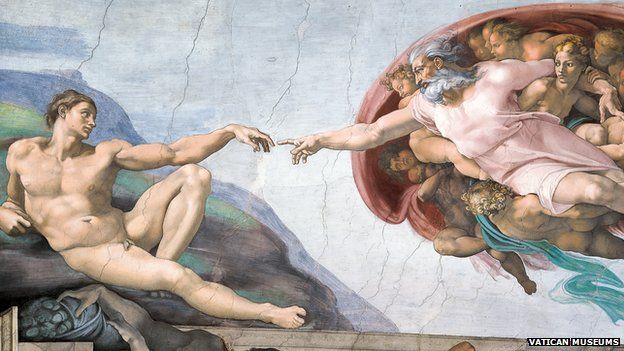Sistine Chapel ceiling at 500: The Vatican's dilemma
- Published

The Vatican has indicated for the first time that it might eventually need to consider limiting the number of visitors to the Sistine Chapel, 500 years after its completion.
Michelangelo's famous frescoes have been described as one of the world's supreme sights.
In scene after scene, some of the Old Testament's most powerful stories unfold.
And at the centre of this vast work is one of the best known images in Western art; the depiction of God reaching out to touch Adam into life.
But for some, the room has become a victim of its own fame and magnificence. They say it just attracts far too many tourists.
Twenty-thousand visitors pour through the Chapel's doors every day; more than five million a year.
And the Italian literary critic, Pietro Citati, recently launched a searing attack on the Vatican authorities for allowing in such huge numbers.
Writing in the pages of Corriere della Sera newspaper he went as far as to describe the crowding on an average visit as an "unimaginable disaster".
"In the universal confusion no-one saw anything," he wrote.
And speaking to the BBC he reinforced his criticism.
"The Sistine Chapel was full of people - a huge crowd, packed tightly together... and they were all breathing! There was this dense 'human-ness'! Human sweat. It was horrendous."
Mr Citati said that this endless, rising, humid "wall of human breath" could be damaging for the priceless frescoes above.
Responding to this kind of criticism, the director of the Vatican Museums, Antonio Paolucci, acknowledged that there was a "serious problem".
He said that the whole doctrine of the Catholic Church was set out in the images in the Sistine Chapel, and that he wanted everyone who visited to be able to appreciate that symbolic system.
But Mr Paolucci accepted that that was not easy to do when the room is packed.
"It becomes noisy, people are confused, bewildered - it's hard to understand." he said. "Too many people make it uncomfortable... and it also creates a problem for the conservation of the frescoes."
Mr Paolucci said plans to improve the ventilation and counter the threat from humidity in the Chapel would be unveiled soon.
But he also said that, ultimately, steps might have to be taken to restrict the numbers allowed in.
"We may get to that point - if necessary - a so-called 'limited number' of visitors," Mr Paolucci said.
"But so far we've tried to avoid this because the Sistine Chapel for those who visit the Vatican is not only a place of art but also a spiritual, religious place."
'A living death'
There is an argument that it should be made as easy as possible for any pilgrim coming to Rome to see this room that has such a significant place in the Catholic world.
And just a matter of weeks ago, in a newspaper article, Mr Paolucci said it would be as "unthinkable" to limit access to the Sistine Chapel as it would be to limit access to the famous shrine at Lourdes.
But the critic, Mr Citati takes a darker view, arguing that it is all about money.
The Church makes a significant amount out of visitors to the Chapel and the other delights of the Vatican Museums.
Everybody in the long queues in St Peter's Square is paying more than 15 euros (£12.50) for a ticket.
But it is possible though to avoid the masses if you can spare close to 220 euros for a private tour. Each involves about 10 people who are allowed into the Chapel outside the standard opening hours.
Mr Citati is not the first person to take issue with the number of visitors being allowed into the Chapel.
Writing shortly before his recent death, the art critic Robert Hughes recalled reading of the German writer, Goethe, visiting the Chapel 200 years ago.
Back then the Sistine was "a place where one could be alone, or nearly so, with the products of genius," Hughes wrote.
"The very idea seems absurd, today; a fantasy. Mass tourism has turned what was a contemplative pleasure for Goethe's contemporaries into an ordeal more like a degrading rugby scrum."
He said that painting was a silent art, that deserved silence from those who came to view it.
But these days the Sistine Chapel is filled with the sound of its murmuring mass of visitors.
And it is hard to ignore the conversations around you.
"Can you imagine someone painting this... with a brush!" an American tourist exclaimed to his companions on a recent visit.
Then they discussed what Michelangelo would have been paid. And soon afterwards they were laughing out loud, thoroughly enjoying themselves but prompting an angry security man to come stalking over, glaring at them, and "shushing".
It was the sort of exchange that drains the place of the spiritual intensity that Michelangelo wanted to give it.
Robert Hughes said the modern atmosphere in the Sistine represented "a kind of living death for high culture" at the hands of mass culture.
And with its talk now of the possibility of eventually limiting numbers, perhaps the Vatican is beginning to feel the same way.
Listen to the BBC Radio 3 series marking the 500th anniversary of the Sistine Chapel ceiling.
- Published5 May 2012
- Published12 March 2012
- Published21 November 2009